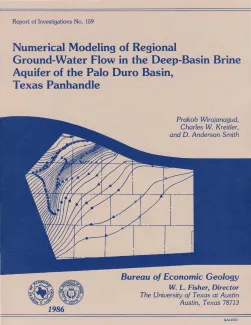
Publication Details
Geolocation:
Get the Publication
$4.50
Abstract/Description:
A conceptual hydrogeologic model of the Palo Duro Basin, Texas Panhandle, subdivides the basin into three hydrogeologic units: (1) the shallow Ogallala and Dockum aquifers (Upper aquifer), (2) the Permian evaporite aquitard (Evaporite aquitard), and (3) the deep, confined, underpressured, principally Permian and Pennsylvanian brine aquifer (Deep-Basin Brine aquifer). The first permeable units beneath the thick Permian evaporite section are Wolfcamp strata composed of carbonates, shales, and arkosic sands and gravels (granite wash) having average effective permeability values of 8.9, 1 x 10 -4, and 8.6 md, respectively. Ground water in the Wolfcamp aquifer flows to the northeast toward the semi-impermeable, granitic Amarillo Uplift. This anomalous hydrologic condition (flow toward a low-transmissivity barrier) appears to result from the presence of highly permeable granite-wash deposits that flank the uplift and function as hydrologic sinks. A two-dimensional finite element model, incorporating different lithologies and their permeabilities as well as leakage values through the overlying Evaporite aquitard, was used to simulate the ground-water flow of the Wolfcamp aquifer. The conditions that best simulate the observed Wolfcamp potentiometric surface are a combination of prescribed heads and no-flow boundaries along the uplift, permeability values of greater than 260 md for the granite-wash deposits that flank the uplift (in contrast to the average value of 8.6 md for the Wolfcamp), and an increased permeability value of 50 md for the highly porous carbonate zone. The best estimate of vertical permeability of the Evaporite aquitard is 8 x 10 -5 md. Another model treating the deep Permian and Pennsylvanian brine aquifer as a single permeable unit beneath the Evaporite aquitard shows that ground-water flow is to the northeast toward the uplift, and a slightly larger west-to-east flow component appears than that found when considering only flow in Wolfcamp strata. Conditions that most accurately simulate the averaged potentiometric surface are those from the simulation of Wolfcamp strata, which have increased permeability values of 260 md for the Pennsylvanian granite wash close to the uplift and 50 md for the high-porosity Pennsylvanian carbonates.